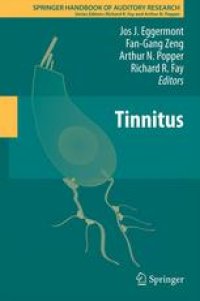
Ebook: Tinnitus
- Tags: Otorhinolaryngology, Neurosciences, Neurology
- Series: Springer Handbook of Auditory Research 44
- Year: 2012
- Publisher: Springer-Verlag New York
- Edition: 1
- Language: English
- pdf
Tinnitus is a prevalent hearing disease, affecting 15% of the population, particularly hearing impaired, veterans and even young people who grow up with mp3 players and iPods. The mechanisms underlying tinnitus remain controversial. At present there is no cure for tinnitus, and treatment options are limited.
Different from previous tinnitus books, including A. R. Moller’s book [in press at Springer], which typically have a strong clinical flavor, the present volume focuses on neural mechanisms of tinnitus and its behavioral consequences. The proposed book starts with a general summary of the field and a short introduction on the selection and content of the remaining chapters. Chapter 2 overviews tinnitus prevalence and etiologies to set the tone for significance and complexity of this neurological disorder spectrum. Chapters 3-8 cover neuroscience of tinnitus in animal models from molecular mechanisms to cortical manifestation. Chapters 9-12 cover human brain responses to tinnitus and it clinical management.
Tinnitus is a prevalent hearing disease in humans, affecting 15% of the population. At present there is no cure for tinnitus, and treatment options are limited. Recognizing the significance of tinnitus to hearing, as well as it serving as a window into the basic science of understanding of the hearing process, Tinnitus provides a broad overview of the topic. The volume focuses on neural mechanisms of tinnitus and its behavioral consequences. The book is divided into two parts to address systematically the current issues in tinnitus research
Historical Reflections on Current Issues in Tinnitus- Jos J. Eggermont and Fan-Gang Zeng
Behavioral Tests for Tinnitus in Animals- Henry E. Heffner and Rickye S. Heffner
Molecular Mechanism of Tinnitus - Marlies Knipper, Marcus Müller, and Ulrike Zimmermann
The Cochlea and the Auditory Nerve as a Primary Source of Tinnitus- Régis Nouvian, Michel Eybalin, and Jean-Luc Puel
Dorsal Cochlear Nucleus: Somatosensory–Auditory Interactions in Tinnitus- Susanne Dehmel, Seth D. Koehler, and Susan E. Shore
The Inferior Colliculus: Involvement in Hyperactivity and Tinnitus- Donald Robertson and Wilhelmina Mulders
Cortex: Way Station or Locus of the Tinnitus Percept?- Jos J. Eggermont
Human Brain Imaging of Tinnitus - Jennifer R. Melcher
The Psychophysics of Tinnitus - Brian C. J. Moore
Stimulating the Auditory System to Treat Tinnitus: From Alleviating the Symptoms to Addressing the Causes - Arnaud J. Noreña
Treatment: Pharmacological, Repetitive Transcranial Magnetic Stimulation, Epidural Stimulation, and Deep Brain Stimulation - Berthold Langguth, Dirk De Ridder, Tobias Kleinjung, and Ana Belén Elgoyhen
About the Editors:
Jos Eggermont is Professor in the Department of Physiology and Pharmacology, and the Department of Psychology at the University of Calgary, Alberta, Canada. Fan-Gang Zeng is Research Director in the Hearing and Speech Lab, University of California, Irvine. Arthur N. Popper is Professor in the Department of Biology and Co-Director of the Center for Comparative and Evolutionary Biology of Hearing at the University of Maryland, College Park. Richard R. Fay is Distinguished Research Professor of Psychology at Loyola University Chicago.
About the Series:
The Springer Handbook of Auditory Research presents a series of synthetic reviews of fundamental topics dealing with auditory systems. Each volume is independent and authoritative; taken as a set, this series is the definitive resource in the field